This is the result of two days labor from yours truly, but would like also to send my warm appreciation to FIDE Master R. aka 2k night, for the enlightenment he provides on Sevillano's knight move on the 25th (25...Nd5).
There are two popular operating system we usually employ in our everyday life. The Professional and the Home edition. The annotated game below is the "Home Edition".
Las Vegas International Chess Festival
Round 6
White GM Bareev, Evgeny (2686)
Black IM Sevillano, Enrico (2557)
The game demonstrate how a humble, weak looking isolated pawn can support the assault of its superior towards victory.
1.d4 Nf6 2.c4 e6 3.Nc3 c5 (The Modern Benoni Defense. IM Sevillano's favorite or "pamatay na opening" (killer opening) if we will allow to use the term the six years old Stephen Rome's Pangilinan to defeat his opponents. The Benoni however is not advisable choice for beginners to study with. Black will opt to fiancetto his king's bishop to g7 playing for a counter attack on the queenside and the semi-open e-file. White on the other hand, will play for a central initiative.
4.d5 exd5 5.cxd5 d6 6.e4 g6 (This is the fianchetto variation of the Benoni. Black will try to unbalance the position and gain active piece play at the cost of allowing White a pawn wedge at d5 and a central majority. White usually plays for a central break with e5, black will undermine this by the push...c5 and if the bishop on g7 stays unchallenged, will give black playing chances.)
7.f4 Bg7 8.Bb5 (the variation white was following has the higher winning percentage according to my opening data base, showing white with 63.4% winning percentage and with performance rating of 2593)
8...Nfd7 9.a4 (during actual games, giving up the b4 square to black brought white no problems at all but Sevillano will use this all important square to his advantage latter in the game. All other possible variations like 9.Bd3, Bd2, and Nf3 appears to favor white considerably.)
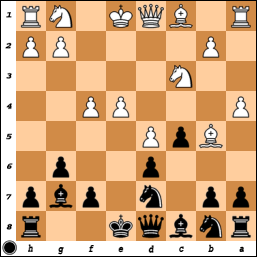
9...Qh4 10.g3 Qe7 11.Nf3 O-O 12.O-O Na6 (That's right kids. Black is now setting his eyes on the b4 square. An ideal outpost for black's knight.)
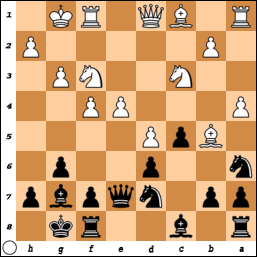
13.Re1 Nb4 (black still has huge loosing percentage in this variation, again, according to my opening database with mere 39.2 % winning percentage for black. Black should be careful. If properly executed by white, the all important b4 square will pose no threat at all with white's plan.)
14.Be3 (Interesting. 14. Bf1 followed by 15.Ra3 or 15.h3 seems better)
At this point, we will rely on human psychology as we follows the moves more than depending on chess computer program in search for tactical possibilities. This blogger is after the drama, doubt, pride, fear, ego etc that represent top class chess game, meaning we will not suggest which is much better move nor present winning variations.
14...Nf6 (Double edge. It allows the black's knight and light squared bishop to come into play.)
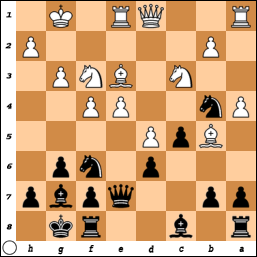
15.Bd2?! (now white obviously overlooked black's follow up move of ...Ng4. Mental lapses in the earlier part of the game are proven to be costly.)
15...Bg4 (pinning the knight on f3 but it also forced the white king away from its comfort zone early in the game.)
16.Kg2 a6 17.Bf1 Qd7 18.Qb3 (bailing out of the annoying pin for good.)
18. Bh3+ (black begins the attack on the whites kingside to freed black's queenside. The exchange of light squared bishop after the kings retreat will favor black in his attempt to gain grounds on the queenside, following the pawn exchange there.)
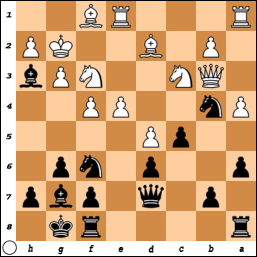
19.Kh1 Bxf1 20.Rxf1 b5! (If the white light squared bishop was still planted on f1, the ensuing exchange of pawns will not be possible.)
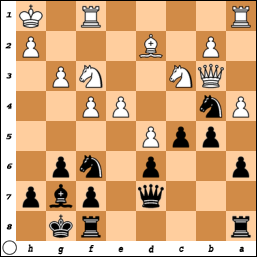
21.axb5 axb5 22.Rad1 Qb7 (black's knight on f6 can use the square d7 left by queen for maneuvering towards the queenside. Black's queen will stay and haunt on the queenside anyway so why not place it where it can be more active and allow other pieces to move more freely?)
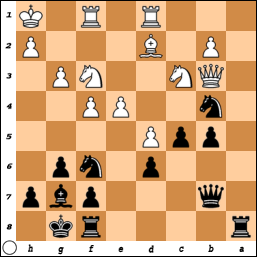
23.Bc1 Rad8 24.Rfe1 Rfe8 25.Kg2 Nd3! (black is inviting white to exchange one of his rooks for his knight and a pawn. Try figuring it out yourself, using psychology over pure calculation before going on to the next moves. Computers will rarely make this kind of move. It's all psychological. Thanks FM R!)
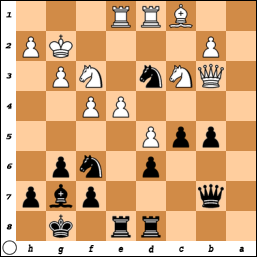
26.Rxd3?! (so white is undeterred. Interesting part here was that, Bareev spent less than 10 seconds to decide for this move. Either Bareev's tactical instinct may have failed him this time or he simply anticipated this move, the result was it keeps black strong. Now the cockiness of human nature when facing such "insulting" move finally comes into the picture, I presume. However, 26.Qxb5 Nxe1 Rxe1 Qxb5 etc or 26. Qxb5 Qxb5 27. Nxb5 Nxe1 28. Rxe1 Nxe4 and black regains the pawn with huge positional advantage for black. On the other hand, moving the threatened rook on e1, will cost white precious time and tempo.)
26...c4 (obviously, the only move.)
27.Qd1 cxd3 28.Qxd3 b4! (Good move. This bold push of an isolated pawn into enemy territory looks ambitious but the move not only pushed the knight back to it's most inactive place at d1, the b4 pawn also allow black's bishop on g7 to lord and rain terror along the a1-h8 diagonal by protecting the c3 square, parrying any attempt by white to challenge the fianchetto bishop at g7, the only piece that can challenge black's dark squared bishop. The white's bishop at c1 can no longer hope of ever maneuvering to c3 via d2 square unless white captures the b4 pawn or force the b4 pawn away from guarding c3. This is key for white. Note that blacks' bishop dominance along the diagonal is supported by this lone, sickly looking pawn. Keep in mind that the b4 square was once occupied by knight who used it as an outpost to forced white to make a difficult decision of giving up one of his rook.)
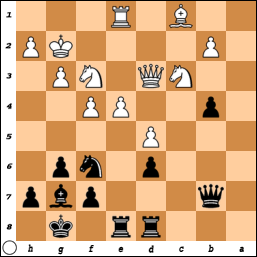
29.Nd1 Rc8 30.Bd2 Nd7 (knight will jump to c5 as the fianchetto bishop on g7 will now plays a big part for the rest of the game who has an unexpected defender way on the other side of the board that is the mighty b4 pawn!)
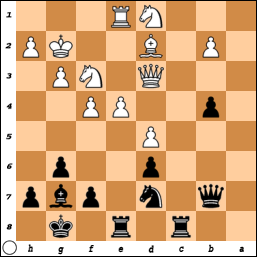
31.Re3? (May not be the best of choice. Black looks to be over protecting the b3 square. As we have stated earlier, Black has no intention of pushing his b pawn from its ideal position. In fact black will gave everything to keep the b4 pawn on its place (by...Rb8) if it came under attack but white is in bad position to execute a good and quick plan to pressure the b4 due to whites pieces poor coordination in the queenside. On the one hand, giving white the benefit of the doubt, white probably chose this rook move to make sure that a piece will first put in front along the e-file and not his queen once her highness were forced to retreat at e2, the only rational square for black queen after blacks' knights occupation of c5.
31...Nc5 32.Qe2 Re7 (an interesting choice by black to double his rook on the e-file. Perhaps black is worried about white's connected passed pawns on d5 and e5 once an exchange of pawns occures there?)
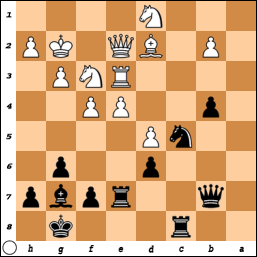
33.Nf2 (Black may have not expecting this or he would not be thinking of doubling his rooks in the first place. On the other hand, White felt that there is no need anymore to protect the b2 pawn and thinks that by delaying black's intention of doubling his rook on the e-file was what matters most to save his game. Interesting choice for both players.)
33...Bxb2 (black is more than happy with this offer. Forget the battery on the e-file)
34.e5 dxe5 35.fxe5 Qxd5 (white's hope for his two connected central passed pawn is now officially over. Black may also have lost all his fighting spirit.)
36.Bxb4 (the b4 pawn has already done its job. Time to let it go. If you are a sentimentalist kind of chess player, it would be sad to see this humble b pawn to be thrown away after playing a big part for black. But white's e5 pawn can pose more threats than the advance of black's b4 pawn for possible promotion.
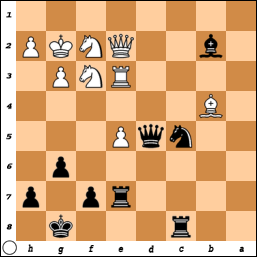
Bd4 37.Bxc5 Bxc5 38.Ne4 Re6 39.Rc3 Kg7 40.Neg5 Re7 41.Qc2 Rxe5 42.Rd3 Be7 0-1
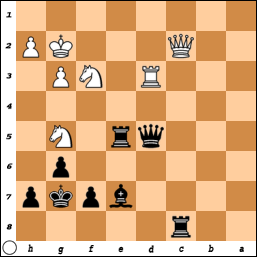
The final position
Sevillano wins the game and eventually, the tournament!










No comments:
Post a Comment